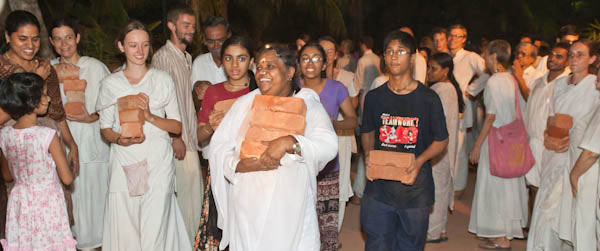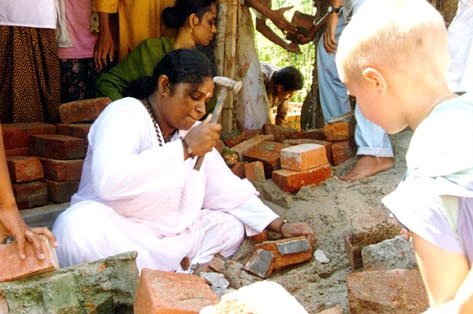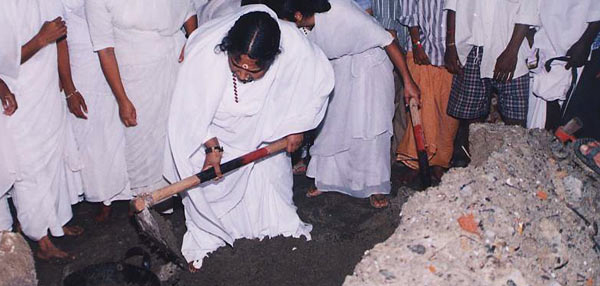| Selfless Seva |

|
Question: Swamiji, Can you explain the importance of selfless seva?
|
Answer: In the Bhagavad Gita, Lord Krishna outlines four primary paths to reach the goal of Self-Realization. They are Raja Yoga, Bhakti Yoga, Jnana Yoga, and Karma Yoga. Karma Yoga, is the path of action.
It is useful to consider the path of action because action is one thing we are all stuck with, whether we like it or not. In the third chapter of the Bhagavad Gita, Lord Krishna explains:
|
na hi kashchit kshanam api jatu tishthatyakarma-krit
karyate hyavashah karma sarvah prakriti-jair gunaih
There is no one who can remain without action even for a moment. Indeed, all beings
are compelled to act by their qualities born of material nature (satva, rajas, tamas).
|
At first glance, we may feel this is not correct. Many times, we feel we are not doing much, and we say ?I didn?t do anything today.? But the truth is, if we look deeply into the matter, we can see that we are always engaged in action.
Even when we are sleeping, there are so many activities happening within us that we are not aware of. The blood is flowing, our lungs are expanding and contracting, our cells repair, our food digests, and our bodies grow taller or wider. So even when we think we are doing nothing, we remain ever engaged in action.
That being the case, it is worth spending some time reflecting on how we can harness our actions to help us to reach our goals, especially the ultimate goal of spiritual realization.
Normally, we perform actions, to fulfill our own selfish desires. These actions may provide us with some temporary satisfaction, but they are never going to lead to lasting peace and happiness.
When we fulfill a desire, immediately another desire will arise in our mind, and then we will feel compelled to fulfill that desire.
And on and on it goes until we die. There is one bhajan that Amma sings very often, almost every time she gives a program anywhere in the world.
The bhajan is called Manase Nin Swantamayi, and its words are profound. Amma gives the bitter medicine straight to us in this bhajan - the unvarnished truth of where we are at.
The fact that she sings it so often means there is a message there that she wants to be sure we hear. In one verse of that bhajan, Amma sings:
Artha Soonyamakum oro Karmangale Cheyuthu Konde -
Wandering in this world, you perform meaningless actions.
Why does this bhajan say our actions are meaningless? In the grand scheme of things, when it comes to the journey of our soul, only actions that help us to reach the supreme goal of Self-realization are meaningful.
|

|
Now, before we panic, the good news: it is easy to start performing meaningful actions. In the Bhagavad Gita, Lord Krishna has made it easy for us with his advice: Transform your karma (action) into karma yoga.
Amma has made it even easier still, by creating so many opportunities to do karma yoga through seva.
In fact, I often wonder if the point of all the service activities that Amma has initiated all around the world, is at least as much to provide opportunities to serve as for the people that are served.
Because when we serve, we are the ones who benefit the most. And Amma has made it possible for anyone with a desire to serve to do so. When you come to the ashram for seva, there are all sorts of things you can do. The seva coordinator will meet you where you are at and find a seva for you according to your capacity. This is because Amma has met all of us where we are, and She finds ways for each of us to do seva.
And don?t worry if you don?t feel truly selfless when you are serving. Doing seva doesn?t mean that we are truly being selfless. In fact, only Saints perform truly selfless actions. Karma yoga, or seva, is the act of training our mind to perform selfless actions, and that, in turn, will take us to the ultimate goal of life.
A normal human mind is always extroverted. From within, it goes outward, associating with the sense organs and the objects of the sensory world. The nature of thought is to dwell on objects, either those in our possession or those possessed by others. Here when we say ?objects,? we mean not only actual objects, such as money, houses, cars, and phones, but also our relationships -- that is, everything that makes up our external world.
In order to progress spiritually, we need to redirect our mind and thoughts ? we need to become more introverted so that we can look within. This is difficult to do directly, but when we perform seva, our mind naturally becomes more introverted, even without our conscious effort. There is a very logical reason for this ? when we do seva, we are intent on doing it well, and we are not thinking about other things. As a result of that awareness and focus on what we are doing, we are more in the present moment. Our mind withdraws from the future where it so often dwells, worried about the results of our actions, and we are able to dwell in the present, focused on the action itself.
The other factor that allows us to dwell more in the present is sraddha, or alertness combined with faith in Amma?s words. When Amma asks us to do something, we do it based on our faith in Amma?s words.
We don?t worry about the reason, and we don?t worry about the result. This allows us to be in the present moment. This also creates a cycle of positive reinforcement, or a ?positive feedback loop,? because if we have spent any time around Amma, we have done things that didn?t make sense to us in that moment, but later on we come to see that it was for our benefit, for our highest good.
It is easier to stay in the present when we are following Amma?s instructions or acting based on our faith in Amma?s words ? and we can do this any time we serve.
It doesn?t have to be a direct instruction from Amma. We know that Amma wants us to serve, to help people, to care for the planet, to give more love and attention to our family and loved ones, to strive to see our unity even with those with whom we have differences.
Any time we do this, it is seva. Any time we do this, we are practicing sraddha.
|

|
It?s also important to spend time thinking about the difference between helping and serving. We normally talk about helping people. But when we are ?helping someone,? we always place ourselves on a higher pedestal, seeing ourselves as above the person we are helping. We have the attitude that ?I? have something that ?you? do not have, and ?I? am helping ?you.? We feel that we are doing them a favor, that we deserve appreciation, and that they should be grateful. No matter how good our intentions are, these feelings will be there somewhere inside us. But when we are serving rather than helping, we are inherently below.
Serving comes from a place of humility. If we see those we are serving as a form of God and view our service to those in need as service to God, then even though we may have a so-called ?higher station in life,? we will see them on a pedestal above us and be grateful they have given us an opportunity to serve. We will also have fewer expectations toward them, and it will be easier to place ourselves in their shoes and fulfill their needs rather than helping them in ?my? way and expecting gratitude in return. We will be more sensitive to their actual needs and their actual situation. Thus, an attitude of serving, or seva, creates more compassion in our hearts, whereas an attitude of helping might even increase our ego.
We also need to think about how to sustain an ongoing practice of karma yoga over the long-term because seva can be like a marriage, and we need to have a plan for when the honeymoon phase is over. When people do seva, initially they do it without any expectation. Because they don?t have any expectation, they are more in the present. And because of being in the present moment, they get a lot of bliss by doing seva, which propels them to do more seva. However, as time progresses, they start liking certain sevas and disliking other sevas, and liking people they work with, or disliking others, and so naturally they lose the innocence and purity with which they initially approached the seva; hence they no longer experience the bliss either. When this happens, rather than losing faith in the value of seva, it?s important to introspect and ask where we have gone wrong. What can we change in our attitude, what can we do to let go of our likes and dislikes, in order to regain that bliss and ultimately experience even more? For if we can consciously make progress in this regard, the bliss will be even more sustainable, and our process of conscious evolution will become a self-fulfilling prophecy.
Just as we are trapped in a cycle of birth-death-rebirth, on a much more micro-level we are trapped in a cycle of action-result-reaction. Reaction itself constitutes another action and leads to another result . . . and another reaction. Doing seva helps us to break this cycle. At least for the time we are doing seva, our ability to focus on the action, and let go of the result, breaks the endless chain we have been trapped in. Doing more seva helps to purify our mind and make it more introverted, and ultimately to break the macro-cycle of birth and death. So, seva is a very concrete and easy way that we can begin to act with awareness and progress toward our goal.
If you ask where is the best time and place to do seva, I would say the second-best place to do seva is here in the ashram, and the second-best time to do seva is any time at all ? there is never a bad time to do seva. But the absolute best time and place to do seva is in Amma?s presence. Now please don?t hear this and decide that is the only time and place you are going to do seva. But doing seva in the presence of a Self-Realized Master like Amma does have a special benefit. We will make progress faster ? our actions will become more selfless and we will experience more compassion, love and bliss. Even if we begin our seva with a selfish motive, Amma will work hard to eliminate our ego (which is the hardest, most thankless job in the world) and in this way, make our actions more selfless and meaningful.
We all know about multinational corporations ? Amma has created a multinational service organization so that wherever we go, we can find an Amma satsang where we can participate in some seva.
|

Return to Newsletter



Browse Q&A Archive
|









